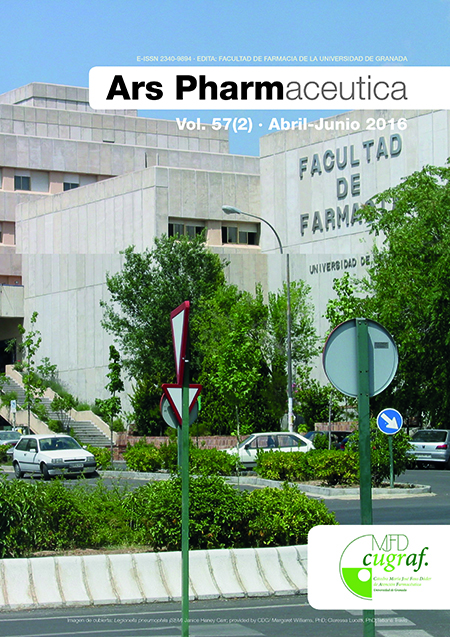Ulva species from San Jorge Gulf, Patagonia argentina: seasonal and spatial biochemical variation and their relation with the production of bioactive metabolites
DOI:
https://doi.org/10.30827/ars.v57i2.4965Keywords:
Ulva, Phenols, AntitumoralAbstract
Aim. To study species of Ulva from San Jorge Gulf, Patagonia Argentina, integrating biochemical aspects, biological activity and seasonal and spatial variations, to determine their potential application in health.
Methods. Algae were collected seasonally on beaches with and without anthropogenic pollution, then dried and ground and the bioactive compounds extracted with ethanol. Extracts were fractionated using solvents with different polarity. Each fraction was characterized using qualitative chemical reactions and chromatography. Fractions rich in flavonoids were analyzed using HPLC-DAD, and lipids were analyzed using TLC. Biological activity was assayed by using the Artemia salina cytotoxicity test and the xanthine oxidase inhibition assay and by studying the inhibitory effect on root elongation, antioxidant activity and antibacterial activity.
Results. Ulva rigida and Ulva lactuca were identified. Flavonoids, tannins, quinones, lipids, carbohydrates, and steroids were identified in both species. U. rigida showed a much greater amount of flavonoids in autumn and winter, whereas U. lactuca did so in spring and winter, especially kayaflavone. Alkaloids were detected in U. rigida (summer). Lipids were high in summer. U. lactuca showed monogalactosyldiacylglycerol in winter and digalactosylacylglyceride and phosphatidylcholine in autumn. The inhibitory effect on root elongation (assumed as antitumor activity) was significant and dose-dependent, U. rigida showed the highest values in autumn and spring (ED50 = 480 and 520 µg/ml, respectively). Other bioactivities were low or negative.
Conclusions. Metabolic differences showed the importance of considering the seasonal-spatial conditions to plan collection of specimens for their study and/or application. This works is the first integral analysis of Ulva species from Patagonia Argentina and shows their potential to exert antitumor activity.
Downloads
Downloads
Published
How to Cite
Issue
Section
License
The articles, which are published in this journal, are subject to the following terms in relation to the rights of patrimonial or exploitation:
- The authors will keep their copyright and guarantee to the journal the right of first publication of their work, which will be distributed with a Creative Commons BY-NC-SA 4.0 license that allows third parties to reuse the work whenever its author, quote the original source and do not make commercial use of it.
b. The authors may adopt other non-exclusive licensing agreements for the distribution of the published version of the work (e.g., deposit it in an institutional telematic file or publish it in a monographic volume) provided that the original source of its publication is indicated.
c. Authors are allowed and advised to disseminate their work through the Internet (e.g. in institutional repositories or on their website) before and during the submission process, which can produce interesting exchanges and increase citations of the published work. (See The effect of open access).























